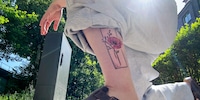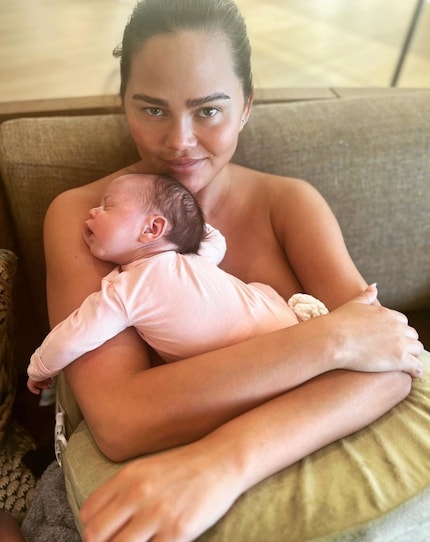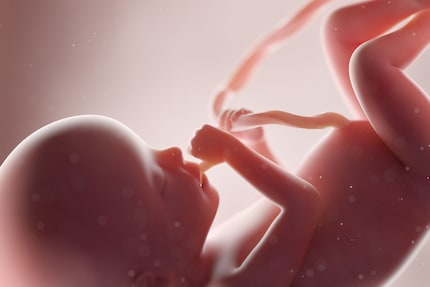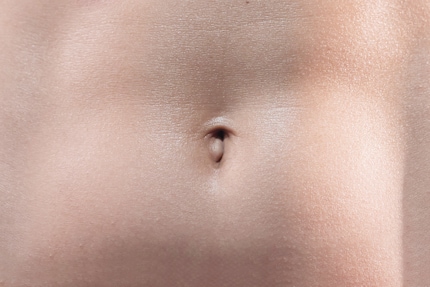
Product test
Fresh tattoo: Which cream is good for what? A self-experiment
by Anika Schulz

The umbilical cord supplies the unborn child with the nutrients it needs. But it also serves as a toy in the womb and can still be useful even after birth. Here, I take a look at this mini marvel. And the scar it leaves.
Have you ever toyed with the idea of storing your child’s cord blood? I haven’t (either). There’s a reason why I’m looking into the topic now, seven years after the birth of my first child: Chrissy Teigen.
If the name doesn’t ring any bells, Chrissy Teigen is a 44-year-old US-American model and mother of three who’s married to singer John Legend. And she just had her newborn’s umbilical cord blood stored. She’s happy to speak openly about it – along with many other family matters.

The headline puzzled me. I know stories and sayings about eating the placenta or planting a tree on top of it. And I’ve already grasped the fact that umbilical cord blood is valuable. But storing it immediately? I wanted to find out more and found ten amazing facts on the subject. Conclusion: the umbilical cord is pretty ingenious!
After birth and clamping the umbilical cord, it retains some residual blood. This contains valuable stem cells that are important for treating blood and immune system diseases. Currently, it’s mainly used to treat children suffering from leukaemia. Parents can also store their child’s umbilical cord blood here: in Switzerland, there are both private umbilical cord blood banks and a public one (site in German). The latter makes the stem cells available to patients worldwide.
In around the fourth month of pregnancy, babies begin to explore their surroundings with their hands, feet and mouth. Ultrasound images show that they reach for the umbilical cord and hold it, forming their first haptic experiences. Pulling or tugging it isn’t dangerous; playing even promotes the growth of the umbilical cord, which is supposed to get longer anyway.

The umbilical cord grows with the baby and, at birth, is about as long as the child is tall at around 50 to 60 centimetres. One in 1,000 babies has an overly long umbilical cord of 80 centimetres or more.
Due to the child’s movements, the umbilical cord often wraps around parts of the body, including the neck. This happens in about 20 per cent of births. One to two per cent of children also slip through the umbilical cord and form knots it in. Most of the time, this isn’t a problem. However, if the umbilical cord is squeezed or pinched off causing an undersupply, intervention is required and the child needs to be delivered.
Hyaluronic acid is best known as an ingredient in anti-ageing creams. But it’s also a natural part of the umbilical cord. So-called Wharton’s jelly contains hyaluronic acid to give the umbilical cord the elasticity it needs – and protect it from bending. It gets its stability from two arteries that spiral around a vein.

Speaking of arteries and veins, arteries normally transport oxygen-rich blood, while veins transport oxygen-depleted blood. Because the foetus depends on the mother’s supply, the opposite applies to the umbilical cord. The vein carries the oxygenated and nutrient-rich blood from the placenta to the foetus, while the arteries carry de-oxygenated blood and waste to the placenta.
With their first breath, the baby no longer needs the umbilical cord, so it’s cut after birth. This is painless because it contains no nerve cells and pathways. The remainder dries up, turns black and falls off after a few days. What remains is the belly button – the first scar in a person’s life. In the first few days after birth, navel care is essential; it has to be disinfected regularly.
The umbilical cord is usually clamped immediately after birth. Now, however, midwives are increasingly delaying this and waiting until the umbilical cord has stopped pulsating by itself and the exchange of blood has stopped naturally. This is intended to give the child an extra dose of blood, and, according to a study of infants in Mexico City, they benefit from a better supply of iron. Umbilical cord blood can’t be donated after delayed clamping.
While the shape of the belly button isn’t quite as unique as a fingerprint, there are countless different types. Its appearance depends mainly on genetic factors; the type of umbilical cord has nothing to do with it. However, a person’s height and weight can change its appearance over time. For most people, the navel pulls inwards, which is referred to as an «innie». «Outies» – when the navel bulges outwards – are rarer. As an adult, the belly button is no longer of any use. In certain operations, however, it provides an important access point to the interior of the body, and surgical instruments are inserted through a small incision in the navel. This method is called single-port surgery.

In Mexico, the umbilical cord is considered a good luck charm and is placed around the newborn’s neck as a necklace. In Japan, it’s cleaned and stored in a box. Kept as a memento, it’s said ensure a good relationship between mother and child for the rest of their lives. In Islamic countries, the cord is traditionally buried near a mosque or thrown into a river after the birth.
Header image: ShutterstockMom of Anna and Elsa, aperitif expert, group fitness fanatic, aspiring dancer and gossip lover. Often a multitasker and a person who wants it all, sometimes a chocolate chef and queen of the couch.